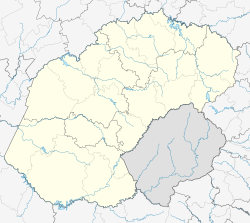Smithfield, Free State
| Smithfield | |
|---|---|

Smithfield Town Hall
|
|
|
|
|
| Coordinates: 30°12′45″S 26°31′53″E / 30.21250°S 26.53139°ECoordinates: 30°12′45″S 26°31′53″E / 30.21250°S 26.53139°E | |
| Country | South Africa |
| Province | Free State |
| District | Xhariep |
| Municipality | Mohokare |
| Established | 1849 |
| Government | |
| • Type | Municipality |
| • Mayor | Motshewa Julia Sehanka (ANC) |
| Area | |
| • Total | 35.5 km2 (13.7 sq mi) |
| Population (2011) | |
| • Total | 4,779 |
| • Density | 130/km2 (350/sq mi) |
| Racial makeup (2011) | |
| • Black African | 91.4% |
| • Coloured | 5.0% |
| • Indian/Asian | 0.3% |
| • White | 3.1% |
| • Other | 0.3% |
| First languages (2011) | |
| • Sotho | 66.9% |
| • Xhosa | 20.9% |
| • Afrikaans | 8.4% |
| • English | 1.3% |
| • Other | 2.4% |
| Postal code (street) | 9966 |
| PO box | 9966 |
| Area code | 051 |
Smithfield is a small town founded in 1848 in the Orange River Sovereignty (as the region was then named). The town situated in a rural farming district, and is the third oldest town in present-day Free State, (after Philippolis and Winburg).
From the 1830s onwards, numbers of white settlers from the Cape Colony crossed the Orange River and started arriving in the fertile southern part of territory known as the Lower Caledon Valley, in which the commonage of Smithfield would later be established. The Lower Caledon Valley, named after the Caledon River that runs through it, was at that time occupied by herders and their cattle under the authority of the Basotho king Moshoesoe. In 1845, a treaty was signed between Moeshoe and the British colonial authorities headed by the Cape Colony governor Sir Harry Smith. The treaty recognised white occupation in the area, though no boundaries were stipulated.
In early South Africa, European notions of boundaries and private land ownership had no counterparts in African political culture. To the local African chieftains, customary tribute in the form of horses and cattle represented acceptance by the reigning chief of land use under his authority. To both the Boer and the British settlers, the same form of tribute was believed to constitute purchase and permanent ownership of the land under independent authority.
According to historical accounts, Moshoeshoe was under the impression he was authorising temporary grazing land to the settlers, while the settlers believed they had been given permanent land rights. Conflicts ensued. The British, who at that time had taken control of the area between the Orange and Vaal Rivers, which they named the Orange River Sovereignty, decided a discernible boundary was necessary and proclaimed a line known as the Warden Line, which divided the area between British and Basotho territories. Smithfield was placed within the British territory and became the colonial administrative centre of what was named the Caledon District. The Mohokare river, meaning "in the midst" (of Basotho territory), which ran close to Smithfield, was renamed the Caledon river, after the Earl of Caledon, British governor of the Cape Colony from 1807 to 1811.
Although land in the district belonged officially to the British Crown, the British civil commissioner of Smithfield, Charles Halse, made a personal fortune speculating in private land deals. In 1854, the British handed over the territory to the Boer republic of Orange Free State, formalised with the signing of the Orange River Convention.
...
Wikipedia



